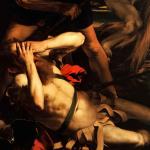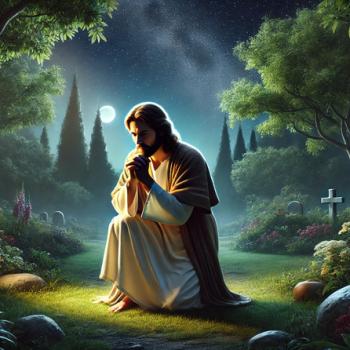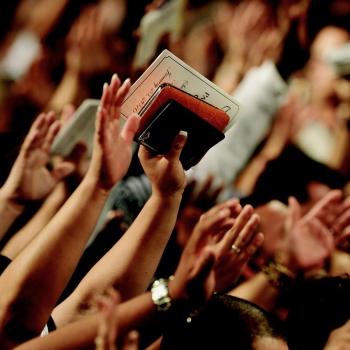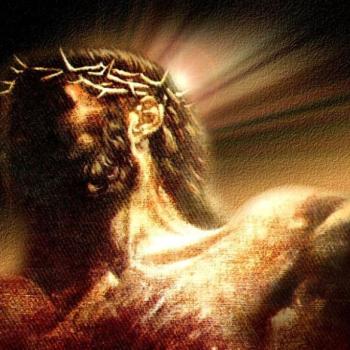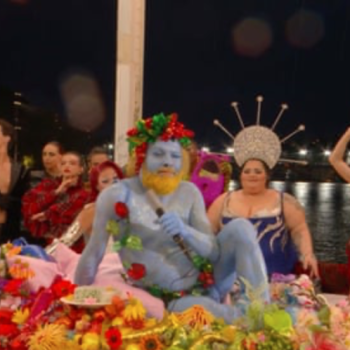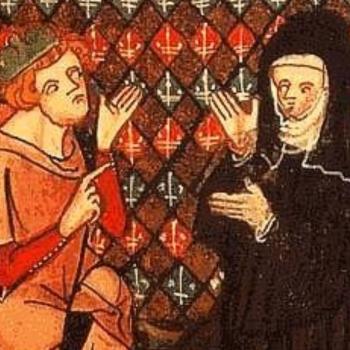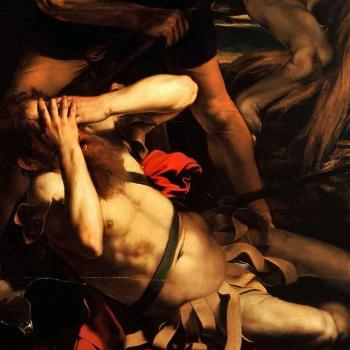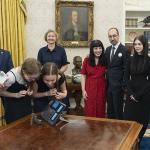This piece is a bit of “first thoughts” on a topic I hope to come back to soon, in a longer, likely more academic forum. The debate around the female diaconate in the Orthodox Church is hot at the moment. A recent conference hosted by the St. Phoebe Center at Hellenic College/Holy Cross and a documentary on Ancient Faith Ministries have reignited the debate. As I say below, I have little investment in the outcome of the debate, but I am troubled by the direction that the tone of the debate has taken. This is my first attempt to put that discomfort into words. —Katie
I will start by saying that I have very little invested in the conclusion of this debate. If women are again ordained to the diaconate in all parts of the Orthodox world, I would not object. If women are ultimately one day ordained to the presbyterate or episcopacy, it will be fine by me. If these things never happen, I would also be just fine. The question of the ordination of women is a very rare thing indeed: A subject on which I have no particular opinion.
What I do care about, however, is how we have this debate. Because regardless of the outcome, the terms on which the debate is held will have consequences for the Orthodox Church and the wider Christian world. The ordination of women to the diaconate has become a litmus test for a certain kind of religious progressivism; yet I cannot help but be struck by how often those making the argument in favor of it repeat arguments that frankly border on misogynistic.It is the kind of misogyny, however, that is cloaked as progress–the kind that argues that to be men’s equals women must be in all things but body men. This misogyny is either ignored or celebrated.
Thus, my purpose here is simple: I wish for us to reconsider the arguments being made in favor of women’s ordination and ask ourselves if this is truly a position we wish to take in the name of women’s dignity and personhood. I wish to ask if the ends justify the means.
To this end, I rely upon two guiding principles: First, I reject clericalism and hold that an ecclesiology that centers ordained ministry and institutionalized liturgical worship is harmful to the health of the Church and the spiritual development of the individual believer. Subsequently, I do not believe that denying a person or persons access to ordination ought to deny that person access to leadership within the Church. In fact, it is harmful that “leadership” has increasingly been associated with ordained orders, a move that undermines the mire of important voices and roles outside of clerical orders. Furthermore, I reject that a) institutionalized liturgical worship is the highest expression of Christian life and b) that participation vis-à-vis clerical or quasi-clerical roles in that liturgy is superior in any way to the lay participation to which we are called.
Clericalism and Liturgicalism
Together clericalism and what I term liturgicalism (that is to say an overemphasis on the act of institutional liturgy and the role of presiders in that liturgy) underlie much of the popular contemporary argument in favor of female diaconate. The result is an argument which ignores and (in some cases, no matter how inadvertently) demeans the non-institutional forms of power which women have traditionally exercised, both within and outside of the church. Dare I say, the definitions being offered of power, service, participation, and leadership are decidedly male, that is to say, public, institutional, and hierarchical.
Arguably this is a position that stems to a certain extent from a much broader worldview that prioritizes the traditional work and roles of men, yet ignores the pivotal roles which women have traditionally occupied. It is also a perspective that has its roots in the Enlightenment’s denigration, and ultimately, near destruction of folk practices of all kinds, including folk religion. These practices have always included a significant role for women, and their marginalization in modernity must be understood as anti-woman (not to mention anti-non-Western in many cases).
The marginalization of midwives in favor of the obstetrician, followed by the systematic exclusion of women from the then professionalized role of birth attendent, is one less spiritually fraught example. The fact that today the majority of labor and delivery residents are women might be seen as a resettling of an upset order, though with appropriate acquiescence to male rules, roles, and institutions.
A Different Kind of Power: Folk Magic and Women
Regardless of whatever Enlightenment bias we might carry, there is power outside of institutions, in the unofficial economies of human society. In the darkest days of the Stalinist persecution of religion, it was not the ordained clergy that the atheist state feared. Rather it was the “babushkas” who Soviet officials understood could and would keep the Orthodox faith alive. While clergy could with little difficulty be identified, rounded up and imprisoned, and while it was certainly possible ultimately to bring the clerical hierarchy of the institutional Church into collaboration, it proved impossible to punish or corrupt every pious grandmother in the country.
These women during the seven decades of Soviet persecution remained the stalwarts of the Christian faith. They whispered prayers over sick children and brought grandchildren to secret locations for baptism. It was precisely their lack of clerical status that allowed them to operate in this prophetic capacity. And while these particular grandmothers found themselves in extreme circumstances, it is difficult to think of a parish community in which it is not the yiayias, babushkas, and tetes who truly serve as leaders and anchors.
For example, it should not go unnoticed that traditionally it is women who have served as nearly every child’s first teachers of the faith, making women from the Resurrection onward truly and consistently the “apostles to the apostles.” This role carries with it significant power and influence. One of the changes that has been introduced to the Church in recent years vis-à-vis the increased number of conversions has been the disruption of this traditional pattern of catechism. For adult converts to the Orthodox faith, their first teachers are rarely laywomen, but instead ordained men. Furthermore, for many of these converts, Orthodoxy is not first encountered in the context of family or community, but alone, though books and blog posts. Books and blog posts whose authors are overwhelming men and clerics.
The Growing Role of the Cleric
This (perhaps unavoidable) reality frequently serves to heighten a spirit of clericalism, suggesting that ordained clerics are the only rightful teachers of Christian faith and that it is in the institutional Church, including through the rituals of the Church, that people are primarily catechized. But the phenomenon of clerics as first teachers and liturgy as the first experience of faith is historically anomalous and arguably has not been without its problems.
One of these problems is that there is no space in this method of catechism for the folk religion that has always run parallel to the institutional Church, often serving as the dominant form of piety. In this form of spiritual experience, women have always been at the center. Women have prophetic dreams and are visited by spirits. It is women who know what herbs to mix and prayers to say to drive away curses, demons, and disease. Women keep and transmit this other form of spiritual knowledge, experience, and practice outside of the institutional Church. And while Protestant missionaries and atheist philosophers have spent the whole of the modern age condemning these beliefs and practices, they have always been at the core of Christian societies and faith. In these societies, there is little doubt that it is laywomen above all who in practice, if not theory, hold the bulk of spiritual power.
The one place within modern Orthodox Christianity where folk religion is preserved largely intact among people of all backgrounds is in the oral (and digital) histories surrounding certain monastic figures. It is not difficult to find circulating internet stories of St. Paisios or St. Seraphim Rose, for example, which are in effect testimonies to folk magic. St. Paisios foretold this coming world event or St. Seraphim dreamed of that pilgrim before his arrival.
These stories preserve the folk religion in its minority form, that is its clerical and masculine form. And because the lay feminine manifestation of these practices (always the majority) are no longer part of most modern Orthodox people’s lives (and a giant surprise to many people from non-traditionally Orthodox backgrounds, people who did not have “that one aunt”), it is easy for these practices to quickly become yet another form of clericalism. Yet it is important to remember that when the whole of our folk practice is intact the kind of mystical powers now reserved to monastic men, and mentioned as part of the narrative surrounding their extreme piety and heightened spiritual development, are commonplace among nearly all women, particularly laywomen. Thus, they offer a completely different picture of what spiritual authority and divine access looks like.
Magic Women (or About My Great-Great Aunt)
When I think of spiritual power, of holiness, of sacramental access, the first image that sprints to mind is not of a priest or bishop, a deacon or monk. It is of Great-Great Aunt Melba, a woman who had helped raise my grandfather and his brothers after their mother’s premature death. That mother had come to Aunt Melba, her younger sister, in a dream the night after she died, holding the baby girl she had left this world trying to bring into it. Aunt Melba could cure the evil eye. She could drive out demons and heal the sick. She could, in effect, do all the things the priest claimed to do as well through their rituals and sacraments, rituals in which Aunt Melba partook and sacraments in which she believed.
She died before I was old enough to ask her the questions I should have: Why both? Whose power is greater? But, prophetess that she was, she answered me. It is silly to think the power of God is shut up in one place or that one ritual (or even many) contains all the ways God moves in the world. It is dangerous to impose the hierarchies of men onto the wonders of God. The priests, the men, had the Divine Liturgy where they were the oracles who stood in the liminal space, and women, we had our dreams, our potions, our healing prayers. Neither was superior to the other. My boy cousins had to go to the altar; I only needed to go to the garden.
I know this separation, even without hierarchy, will rub some people the wrong way. “Let boys go to the garden too,” they might say. “And girls can then go to the altar.” Perhaps, perhaps that is the world we live in now. Certainly modern men have worked their way into other places that were once solely the domain of women, the aforementioned obstetricians for instance (and let’s not forget this kind of assumption of a traditionally women’s role by men has almost always been tantamount to a hostile takeover). But in the context of the Orthodox faith, I don’t see anyone arguing that men and boys should have a share in the traditional work of women.
I see no mothers writing emotional blog posts about how their sons want to learn about herbal remedies or how to cast off the evil eye. In fact, it appears we have forgotten the women’s liturgies all together, dismissed them as superstition. In a handful of cases, it has become clear to me that some of the most public self-declared defenders of women’s inclusion in the Church are quite dismissive of women’s historical spiritual practices. The women combing ancient manuscripts for any evidence that they can serve the Divine Liturgy as deacons seem decidedly uninterested in our grandmother’s rituals. The message is clear: Equality and dignity demand a piece of the masculine share for all. Who would want the worthless stuff of women?
I have thought a lot about Aunt Melba as I have seen the arguments about altar girls and deaconesses play out. I suspect that like me she probably wouldn’t care one way or the other, but I know she would have something to say about the constant insistence that the institutional liturgies of the Church are the highest form of spiritual experience and that real participation in them means having a job up front. She would wonder perhaps how we lost the spiritual gifts she knew so well. She was wise and would notice that no one seems to even remember there are also women’s prayers.


